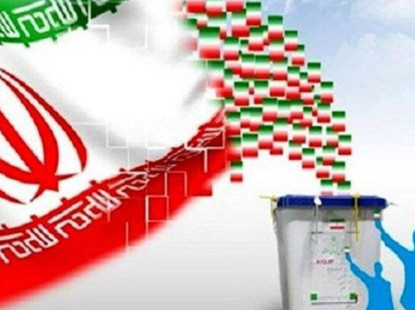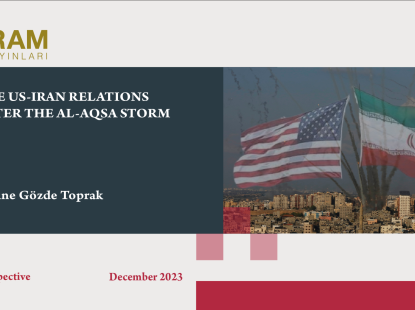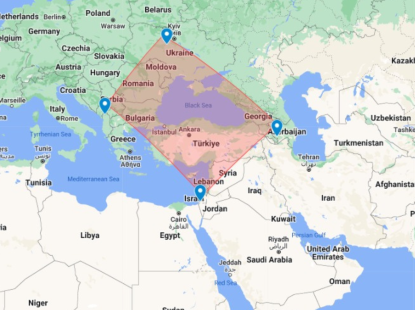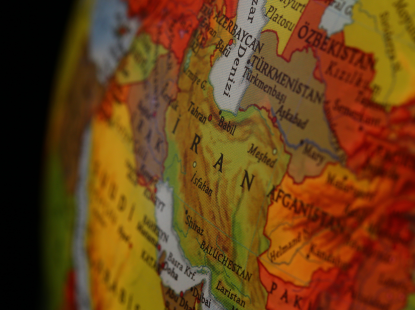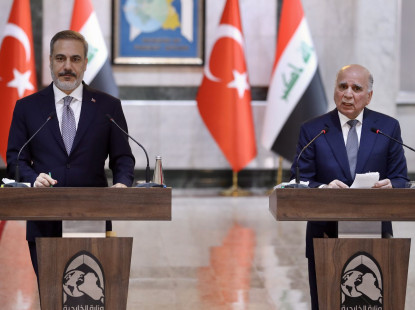Iran's most important strategic goal in the Horn of Africa is to penetrate the Red Sea outlet, which is perhaps the most important of the global waterways.
Iran's Growing Presence in the Horn of Africa and Yemen
The Horn of Africa is an important region due to its strategic location, rich natural resources and cultural diversity. Comprising Somalia, Ethiopia, Djibouti and Eritrea, it lies at the eastern tip of the African continent and provides access to one of the world's busiest sea lanes. The Horn's proximity to the Suez Canal makes it a critical transit point for trade between Asia and Europe. Political instability in the region, particularly the situation in Somalia, has drawn the attention of the international community and raised security concerns. In addition, the region's rich natural resources offer economic potential. All these features make the Horn of Africa a strategic region not only for Africa but also for the world.
The region is characterized by intense movement of people and goods. This naturally affects the security and political dynamics of the region. There are complex problems and conflicts among the countries of the Horn of Africa (Somalia, Ethiopia, Eritrea, and Djibouti). These problems are often based on various factors such as border disputes, ethnic conflicts, civil wars, terrorism, refugee crises and competition for water resources. In particular, the border dispute between Ethiopia and Eritrea is one of the most important problems in the region. The 1998-2000 war led to prolonged tensions over the border. Conflicts between the Oromo and Amhara groups within Ethiopia are another major issue threatening the stability of the region. The protracted civil war in Somalia and the activities of the terrorist organization al-Shabaab have created security and stability problems in the region, as well as serious humanitarian crises. The conflicts in the region have led to massive refugee flows, particularly from Ethiopia and Somalia, resulting in difficult living conditions in refugee camps in neighboring countries.
This insecure environment and the global importance of the region make it an area of active presence for global actors as well as Israel, the United Arab Emirates, Saudi Arabia, and Turkey. The Islamic Republic of Iran, on the other hand, has generally considered the whole of Africa as its sphere of action since the revolution and has shaped its policies accordingly. In line with this policy, Iran has been active throughout the continent, from Western Sahara to Somalia, from Algeria to South Africa, and in each region its strategic objectives have been built on different grounds and tailored to the conditions of the region.
Iran's main strategic goal in the Horn of Africa is to penetrate the outlet of the Red Sea, perhaps the most important of the world's waterways. For this reason, Iran's policy in the Horn of Africa and the recent activities of its proxy forces in Yemen should not be viewed in isolation. By undermining the security of maritime navigation in the region through the Houthis, which was already on the agenda with Somali pirates, Iran has embarked on a show of force. "When the Americans are in the Gulf, they know that they are in a bag, and the mouth of the bag (the Strait of Hormuz) is in our hands, and it is completely within the range of our missiles and capabilities, and they never try to clash with us or create a problem," Rear Admiral Alireza Tangsiri, commander of the IRGC Navy, said on November 27, comparing the Persian Gulf to a bag and the Strait of Hormuz to the mouth of the bag. Today, this is Iran's strategic goal regarding the security of the Bab al-Mandeb Strait. It seeks to hold the mouth of the "bag" at the other end of the Arabian Peninsula, particularly through Yemen and Djibouti.
The control of Iran and its proxies over Yemen is obvious. A similar struggle is taking place across the strait. There is also a significant Yemeni population living in the Horn of Africa, some of whom are said to have ties to Iran. According to experts in the field, madrassas in Yemen are openly seen as a source of terrorism and are marginalized by some segments. According to another expert on the subject, Iran is trying to gain space by scratching the aforementioned problems.
In fact, for a long time Iran has found it difficult to create the space it wants in the countries of the Horn for a variety of reasons. For this reason, Iran has positioned itself on the periphery of the Horn and has established a presence in countries such as Uganda, Tanzania, Kenya, and Yemen. Iran plans to expand the export of its technology products to countries around the Horn of Africa, such as Uganda, Kenya, and Tanzania. It seeks to increase its exports in the fields of health (pharmaceuticals and medical equipment), agriculture, livestock, machinery, food and industry. In July, Iranian companies signed agreements to export medical equipment and pharmaceuticals to Africa. Iranian President Ebrahim Raisi has toured Africa, including Kenya, Uganda, and Zimbabwe. He intends to open an innovation and technology house in Kenya to export technological products of Iranian knowledge-based companies to the East African market. After a seven-year break in diplomatic relations with Sudan, which were severed in 2016, a decision was taken to restore diplomatic ties and steps have been taken in this direction. Following high-level contacts in recent months, there are also plans to reopen embassies and exchange official delegations.
There are basically three reasons for Iran's easy presence in the region, which has been conducting an active policy around the Horn for years. These can be classified as; 1. Weak central governments 2. The existence of a Muslim or easily Islamized population 3. The ability to compete with other rivals.
The weakness of central governments is a very important issue for Iran, especially in terms of proxy power building. This is because Iran develops its presence through "liberated" regions, taking advantage of the conflicts between armed structures that seek to fill the power vacuum that exists almost everywhere. Azerbaijan is a good example in this regard, as almost all of its population is Shiite and has much in common with Iran. For many years, Iran has been trying to influence Azerbaijan through proxy power activities, but it has failed. The main reason for this failure is the existence of a strong central government in Azerbaijan. This is because Iran's proxy power activities, especially through the Husseiniyyun organization, were prevented by the Azerbaijani security units and the organization was successfully pacified in the country. However, this has not been the case in states such as Iraq, Syria, Yemen, and Lebanon. Almost all of these countries rank high in the Fragile States Index almost every year. In the 2023 Index, Iraq ranked 27th out of 179 countries, Syria ranked 5th, Lebanon ranked 25th, and Yemen ranked 2nd. This confirms the above. Countries in the Horn of Africa also top the list. Somalia ranks 1st, Ethiopia 11th, Eritrea 19th, Djibouti 45th in the same list. Other African countries with which Iran has close relations are also in the top 20.
In sum, Iran has the opportunity to move out of the periphery where it has been for a long time and find a space to act directly on the horn. In particular, Israel is actively following the issue and Israeli sources are publishing more frequently. The visit of the Israeli Prime Minister to Kenya on July 17, five days after the visit of Ibrahim Reisi to Kenya on July 12, is also a clear reflection of this struggle. The same sources also report that Iran is involved in oil and arms smuggling in Somalia and Djibouti. Israeli and American think tanks have published report after report on this issue. Accordingly, through these smuggling activities, Iran not only eases the burden of the embargo, but also provides arms and material aid to groups in the region.
Several names have been mentioned in connection with Iran's smuggling activities in East Africa, most notably Mohammad Said Guedi. Guedi, a prominent Djiboutian businessman and philanthropist, is known by many sources for his smuggling and mafia ties. His activities through his companies, such as supplying weapons to al-Shabaab and the Houthis in Yemen, have been reported in open sources, particularly on social media. It has been widely reported that his charitable activities are in fact a "front". Iran is also reported to play a major role in oil and arms smuggling activities in the region.
Apart from all these activities, Iran's activities on "humanitarian" issues are also yielding some results. According to experts in the field, some groups in the region are changing their religion or sect and converting to Shia. In some places, people have started getting Zulfikar tattoos. Images on social media and reports from Israel confirm this situation. For example, pictures have gone viral of members of the Maasai tribe, who live in the border region of Tanzania and Kenya in East Africa, re-enacting the Ghadir-i Hum event, which is very important to Shias and celebrated as a feast, and dancing while chanting "Ali Mawla." Images of African children who singing “Ali Mawla” have also gone viral. (Prophet Muhammad is believed to have said at Ghadir-i Hum: "Whose mawla am I, Ali is his mawla.")
As a result, the groups' activities in Yemen have coincided with a period in which Iran's position in the Horn of Africa has become relatively more secure. Demonstrating its ability to hold the mouth of the "bag", Iran is trying to extend the axis of resistance to the opposite shore of Yemen. Although it is a topic for another study, it is worth noting that almost every day in Iran there is news about the vision of the navy and many steps have been taken to increase the capacity of the navy. All these activities should be read in parallel with Iran's foward defense and deterrence concepts.




